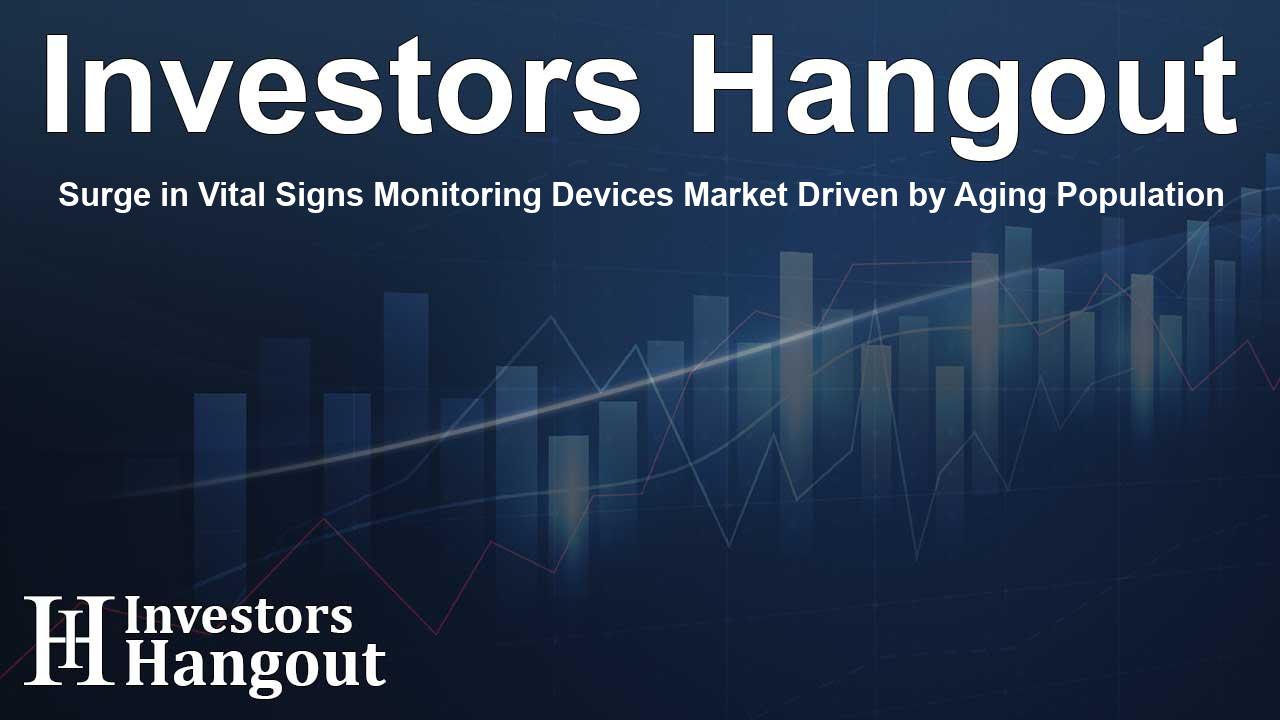Surge in Vital Signs Monitoring Devices Market Driven by Aging Population

Vital Signs Monitoring Devices Market on the Rise
The global vital signs monitoring devices market is witnessing notable growth, having been valued at US$ 5,628.7 million last year and projected to escalate to US$ 9,349.3 million in the near future. This impressive growth rate, which stands at a CAGR of 5.8% from 2025 to 2033, is fueled by various factors that are reshaping the healthcare landscape.
Growing Investment in Healthcare Infrastructure
The surge in demand for continuous monitoring devices is primarily driven by substantial investments in hospital infrastructure, particularly in emerging economies. Nations committed to enhancing their healthcare facilities are actively seeking to improve patient care by reducing patient-to-bed ratios that often exceed 1:1000 in many areas. With nations like India and Brazil investing heavily in healthcare upgrades, the focus is shifting toward networked monitoring systems designed to track essential health metrics.
Government Initiatives
Government policies play a crucial role in this trend. For instance, India’s PM-ABHIM scheme and Brazil’s Health Infrastructure Investment Program have allocated significant financial resources toward bolstering public health infrastructure. This creates an intrinsic demand for advanced monitoring systems capable of tracking vital signs seamlessly.
Aging Population and Demand for Monitoring
As the global population ages, there is an increasing need for devices that can monitor vital signs over extended periods. The demographic shift is particularly pronounced in both developed and developing countries, where over 771 million people are aged 65 and older. This aging population is more susceptible to chronic illnesses that necessitate continuous monitoring, thereby propelling the demand for innovative health monitoring solutions.
Long-term Care Needs
Healthcare systems are adapting to accommodate outpatient models, with home and portable monitoring solutions becoming essential. In regions such as Japan and Western Europe, health monitoring devices with integrated alert systems have become pivotal for clinical workflows, enabling timely interventions and better patient outcomes. Companies like Omron Healthcare and Nihon Kohden are at the forefront of this evolution, developing sophisticated monitoring solutions that leverage AI to predict health fluctuations.
The Impact of Telemedicine
The synergy of telemedicine and vital signs monitoring technologies is transforming healthcare delivery, especially in remote or underserved areas. Following the global pandemic, virtual healthcare models have become integral to service offerings, with telemedicine growing rapidly since 2020. This evolution has been closely tied to the reliability and functionality of monitoring devices that transmit real-time patient data.
Remote Monitoring Innovations
Innovative companies such as Medtronic, Masimo, and Biobeat are pioneering cloud-compatible solutions that enable the continuous flow of health data, facilitating more accurate diagnostics during virtual consultations. The growing acceptance of remote care has changed procurement strategies, leading to an increased focus on bulk purchases of remote monitoring kits.
The Rise of Wearable Technology
Wearable technology has revolutionized health tracking by making it possible to monitor vital signs outside traditional clinical environments. These devices are now essential for a variety of medical applications, including ambulatory monitoring and post-operative care. Key players in the market are continuously improving their offerings, with devices capable of tracking ECG, SpO2, and temperature gaining regulatory approvals.
Benefits of Wearables
Unlike conventional monitors, wearables are designed for extended usability, featuring long battery lives, wireless connectivity, and minimal need for user intervention. The growing trend is supported by health insurance companies that are increasingly offering reimbursement for the use of FDA-approved wearable technologies, effectively aligning clinical practices with modern device capabilities.
Enhancements in Emergency Medical Services
Emergency medical services are integrating portable vital signs monitors to significantly enhance their operational efficiency. In many high-income countries, first responders are now equipped with advanced monitoring tools that can transmit patient data in real-time, enabling proactive treatment decisions before a patient arrives at the hospital.
Innovative Monitoring Systems
Devices such as those produced by Zoll Medical and Mindray, which include features like real-time ECG telemetry, are becoming standard in ambulances. This approach ensures that the health data of emergency patients is accurately conveyed to hospitals, allowing for quicker, better-informed responses.
Insurance Dynamics and Device Procurement
Health insurance providers are shaping the landscape of device procurement by transitioning toward value-based care reimbursement models. This shift results in increased receptivity toward technology that effectively reduces the need for readmissions and emergency visits.
Collaborative Models with Manufacturers
Healthcare systems are now focusing on evaluating the total cost of ownership (TCO) for monitoring devices. Collaboration with manufacturers to establish risk-sharing agreements is incentivizing the adoption of technologies that demonstrate clear economic advantages, fundamentally changing the dynamics of healthcare technology procurement.
Private Sector Investment in Monitoring Technologies
The influx of private investment in the healthcare sector is pivotal in driving advancements in vital signs monitoring technologies. Venture capital funding has exceeded $50 billion, enabling rapid development and distribution of leading-edge devices.
The Future of Health Technology
Companies are exploring diverse sales models that cater to both providers and consumers, thereby emphasizing long-term patient engagement and value creation. The competitive landscape is evolving as businesses transition from hardware sales towards comprehensive service models encompassing ongoing patient care.
Frequently Asked Questions
1. What are vital signs monitoring devices?
Vital signs monitoring devices are used to assess key health parameters such as heart rate, blood pressure, respiratory rate, and more, ensuring continuous patient monitoring.
2. Why is the demand for these devices increasing?
The increasing aging population worldwide and rising prevalence of chronic diseases surface the necessity for continuous monitoring and timely healthcare interventions.
3. How is telemedicine contributing to the market growth?
Telemedicine is enhancing healthcare delivery efficiency by integrating vital signs monitoring technologies, allowing for real-time patient data tracking even from remote locations.
4. What are wearable monitoring devices?
Wearable devices are health monitoring tools that can be worn on the body, designed to continuously track various health metrics while ensuring ease of use for patients.
5. How is private investment impacting the market?
Private capital is propelling innovation and accelerating the commercialization of monitoring devices, driving advancements in technology and distribution channels.
About The Author
Contact Riley Hayes privately here. Or send an email with ATTN: Riley Hayes as the subject to contact@investorshangout.com.
About Investors Hangout
Investors Hangout is a leading online stock forum for financial discussion and learning, offering a wide range of free tools and resources. It draws in traders of all levels, who exchange market knowledge, investigate trading tactics, and keep an eye on industry developments in real time. Featuring financial articles, stock message boards, quotes, charts, company profiles, and live news updates. Through cooperative learning and a wealth of informational resources, it helps users from novices creating their first portfolios to experts honing their techniques. Join Investors Hangout today: https://investorshangout.com/
The content of this article is based on factual, publicly available information and does not represent legal, financial, or investment advice. Investors Hangout does not offer financial advice, and the author is not a licensed financial advisor. Consult a qualified advisor before making any financial or investment decisions based on this article. This article should not be considered advice to purchase, sell, or hold any securities or other investments. If any of the material provided here is inaccurate, please contact us for corrections.
